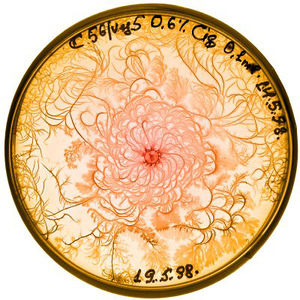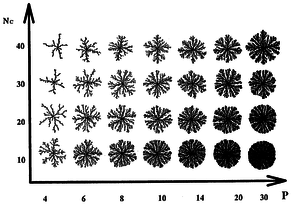Patterns of Bacterial Growth: Difference between revisions
| Line 35: | Line 35: | ||
what is it? | what is it? | ||
identifying characteristics: | identifying characteristics: A bump or branch that sticks out will not be rounded or smoothed over by new growth, but emphasized. It's more likely to catch a wandering particle because it has three facets available for growth, compared to a particle in a line, which only has one facet. | ||
==Agar Density== | ==Agar Density== | ||
Revision as of 03:09, 8 November 2013
Introduction
For the purposes of identifying patterns of growth, bacteria colonies can be through of as multicellular organisms. (info about communication)
Patterns of growth are a result of bacteria adapting their behavior to suit their environment.
Select a topic that includes microbes (bacteria, protist, fungi, or algae). Any kind of topic is possible, because all living organisms and ecosystems include microbes. For example, Google "kangaroo bacteria".
Compose a title for your page. Type your exact title in the Search window, then press Go. The MicrobeWiki will invite you to create a new page with this title.
Open the class template page in "edit." Copy ALL the editable text. Then go to YOUR OWN page; edit tab. PASTE into your own page, and edit.
At right is a sample image insertion. It works for any image uploaded anywhere to MicrobeWiki. The insertion code consists of:
Double brackets: [[
Filename: PHIL_1181_lores.jpg
Thumbnail status: |thumb|
Pixel size: |300px|
Placement on page: |right|
Legend/credit: Electron micrograph of the Ebola Zaire virus. This was the first photo ever taken of the virus, on 10/13/1976. By Dr. F.A. Murphy, now at U.C. Davis, then at the CDC.
Closed double brackets: ]]
Other examples:
Bold
Italic
Subscript: H2O
Superscript: Fe3+
Diffusion-Limited Aggregation
what is it?
identifying characteristics: A bump or branch that sticks out will not be rounded or smoothed over by new growth, but emphasized. It's more likely to catch a wandering particle because it has three facets available for growth, compared to a particle in a line, which only has one facet.
Agar Density
Include some current research, with at least one image.
Nutrient Density
Include some current research, with a second image.
Conclusion
Overall text length should be at least 1,000 words (before counting references), with at least 2 images. Include at least 5 references under Reference section.
References
Edited by Eleanor Lopatto, student of Joan Slonczewski for BIOL 116 Information in Living Systems, 2013, Kenyon College.



